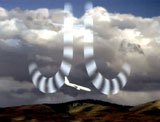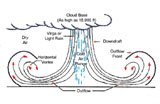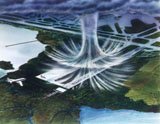Windshear
Windshear is any rapid change in wind direction and/or speed. Severe windshear is a change greater then 15 knots (about 17 miles per hour) or vertical speed change greater then 500 feet per minute (around 5 to 6 mph in the vertical direction). A sudden change in wind speed can change the aircraft's airspeed and therefore can change the amount of lift that keeps your aircraft in the air. When your aircraft is going slow, as in landing or takeoff, then this can get to be a potentially dangerous situation.
Most windshear happens with microbursts that are produced by thunderstorms. Microbursts are powerful and intense downdrafts. They are like a giant hand pushing you down.
There can be wet or dry microbursts. Wet microbursts are normally associated with heavy rain. Dry microbursts are associated with a phenomena called Virga. Virga is rain that evaporates before it reaches the ground, normally in drier climates.The rain will then evaporate which causes a cooling of the air, which causes a downdraft. A ring of blowing dust on the ground is another visual sign of a potential dry microburst.
The size of a microburst is usually less then a mile in diameter. As it descends towards the ground, it can spread out to almost 2.5 miles in diameter.
The microburst downdraft can be as strong as 6,000 feet per minute, and the horizontal shear near the ground can be as much as 45 knots (about 52 miles per hour). This means that there can be a 90 knot differential experienced (headwind to tailwind change) on takeoff or landing, within a few hundred feet of the ground. It can last as long as 15 minutes.
There are a couple of ways that your pilots can use to predict windshear and microburst potential. If the spread between the outside air temperature and dew point is large, then there is a good chance of windshear from microbursts. Many airports have LLWAS (Low Level Windshear Alert Systems) and Terminal Doppler radar to help detect microbursts. Onboard your aircraft, your pilots have weather radar to pick out thunderstorms. Probably the best thing available is that they have reactive and predictive windshear detection radar systems (more on these in another section to come!) that most all airline aircraft have nowadays.



Windshear
Microburst
Microburst
Windshear back to My Airline Flight